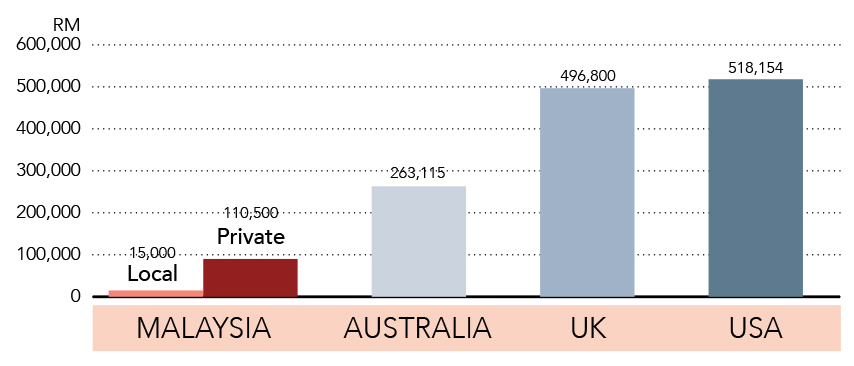FACTOR IN LIVING EXPENSES
According to the OCBC Life Goals calculator, which uses data fed into it to calculate tuition fees and living expenses, the average cost to pursue a tertiary education abroad currently adds up to RM1,355,000 in the US and will increase to RM1,521,000 within three years. In the UK, the cost is RM732,000, rising to RM903,000 within three years, and RM593,000 in Australia, going up to RM668,000.
TWINNING PROGRAMMES
Students who choose to study locally but still want overseas exposure, can choose foreign institutions with a local campus, local private universities that have partnerships with foreign universities, or degree transfer programmes that allow them to complete half their credits in Malaysia.
According to a recent report on a 2+1 programme at a popular local private university, doing the final year abroad could raise the total cost of a degree by RM100,000. The popular American Degree Transfer programmes charge by credit hours.
The total credit hours required for graduation range from 110 to 140, and the cost of one credit hour in a popular Malaysian private university could go up to RM600. That means at least RM36,000 for the first two years of study, and two more years of international fees in the US or Canada.
LOCAL PRIVATE UNIVERSITIES
Private universities offer students more spots for popular courses and opportunities to go abroad. However, the cost is many times higher than that of a public university. Prior to studying for a degree, students must take pre-university courses, such as the A-levels, Canadian Pre-U, International Baccalaureate Diploma or foundation in arts or science.
According to EduAdvisor, going for a one-year foundation programme can cost from RM8,300 to RM24,300 for arts and RM9,700 to RM28,300 for science courses at a local private university. Local private universities are at the lower end of the price range, with foreign institutions with a local campus at the higher end. A-levels is another popular option for students.
The 18-month programme can cost from RM14,900 to RM65,300 for courese in the humanities and RM19,100 to RM65,300 for science. But bear in mind, this is just the beginning for tertiary education. If students go on to a degree programme, the cost can vary widely. Looking at popular courses like business, the total estimated cost of studying can range from RM39,310 to RM110,500. At the higher end are foreign institutions with a local campus, while at the other end are the more affordable local private universities.
LOCAL PUBLIC UNIVERSITIES
Public universities offer an affordable and quality education to students who want to remain on homeground. Students can enter university after the STPM or via the Malaysian Matriculation Programme, which are more affordable than A-levels or even a Diploma. According to a report last year, the total cost of tuition fees for a highly-ranked public university can range from RM7,500 to RM15,000 for the entire length of study.
Arts and business-related courses are more affordable than science subjects, such as medicine and engineering. Another affordable and popular public university charges fees from RM1,900 to RM3,900 for three or four years of study. Registration fees for both schools are generally below RM1,000. But competition for spots in public universities can be an issue as they tend to go to the creme de la creme.
It might be difficult to get into the popular courses, such as engineering and medicine, without stellar results. The high price tag of pursuing tertiary education can be a burden for the family. This is why parents should begin preparing early to ensure they can give their children the best future they can get.

















